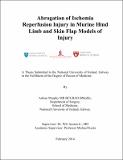| dc.contributor.advisor | Kerin, Michael | |
| dc.contributor.author | Murphy, Adrian David | |
| dc.date.accessioned | 2015-11-25T09:52:59Z | |
| dc.date.available | 2015-11-25T09:52:59Z | |
| dc.date.issued | 2015-03-05 | |
| dc.identifier.uri | http://hdl.handle.net/10379/5348 | |
| dc.description.abstract | Introduction/Aim
Ischemia Reperfusion injury is a poorly understood entity with wide-ranging clinical
implications touching on most fields of clinical medicine. Using skin flap and hind limb
models of injury in the mouse we attempt to reduce ischemia reperfusion injury by
targeting different parts of the ischemia reperfusion injury pathway.
Methods
Dorsal lateral thoracic artery island skin flaps (3.5x1.5 cm) were elevated in C57BL/6
mice and rendered ischemic for 10 hours by placing a 7 mm microclamp on the vascular
pedicle followed by 7 days of reperfusion. Hind-limb ischemia (was achieved with
orthodontic rubber bands applied above the greater trochanter of male C57BL/6 mice
using a McGivney Haemorrhoid Ligator. Limbs underwent ischemia for two hours
followed by 24 hours reperfusion prior to euthanasia. Animals were treated with intravenous
Poloxamer 188 and P8 IgM-binding protein to assess their effect on ischemiareperfusion
injury.
Results
Administration of P188 prior to ischemia gave an average injury score of 8% which was
significantly lower than the control group, injury score 55% (p<0.001). When
administered just prior to reperfusion 12% injury was seen in the P188 group compared
to 33% in the control group (p<0.001). Similarly when given two hours post-reperfusion
P188 treated animals had 14% injury, compared to 38% injury in the control group
(p<0.001). There was, however, no protection seen when treatment was given four hours
post-reperfusion. In animals treated with P8 peptide, there was 14.61±2.77% flap necrosis. This represents
a statistically significant 56% reduction in flap necrosis compared to controls (p<0.001).
Conclusion
Single dose P188 administered to animals undergoing hind-limb ischemia results in an
increased myocyte survival rate following IR injury. This therapy is effective in pretreating
animals as well as in a post-hoc, salvage role. We hypothesize that this effect is
most likely due to P188 inserting into membrane defects and allowing membrane repair.
This degree of protection from IR injury is comparable to the best results in other studies.
P8 blockage of a specific IgM can protect against IR injury in an axial skin flap. This
type of protection could be useful in improving results in free flap transfer and composite
tissue transplantation. | en_IE |
| dc.rights | Attribution-NonCommercial-NoDerivs 3.0 Ireland | |
| dc.rights.uri | https://creativecommons.org/licenses/by-nc-nd/3.0/ie/ | |
| dc.subject | Ischemia reperfusion injury | en_IE |
| dc.subject | Department of Surgery | en_IE |
| dc.subject | School of Medicine | en_IE |
| dc.title | Abrogation of ischemia reperfusion injury in murine hind limb and skin flap models of injury | en_IE |
| dc.type | Thesis | en_IE |
| dc.local.note | This thesis investigates a number of treatment modalities aimed at reducing and/or reversing the effects of ischemia reperfusion injury. The original research work uses mouse models of skeletal muscle and systemic injury (hind-limb model) and skin (skin flap model). End points used include degree of muscle death, degree of skin death, muscle ATP levels as well as animal survival | en_IE |
| dc.local.final | Yes | en_IE |
| nui.item.downloads | 239 | |


